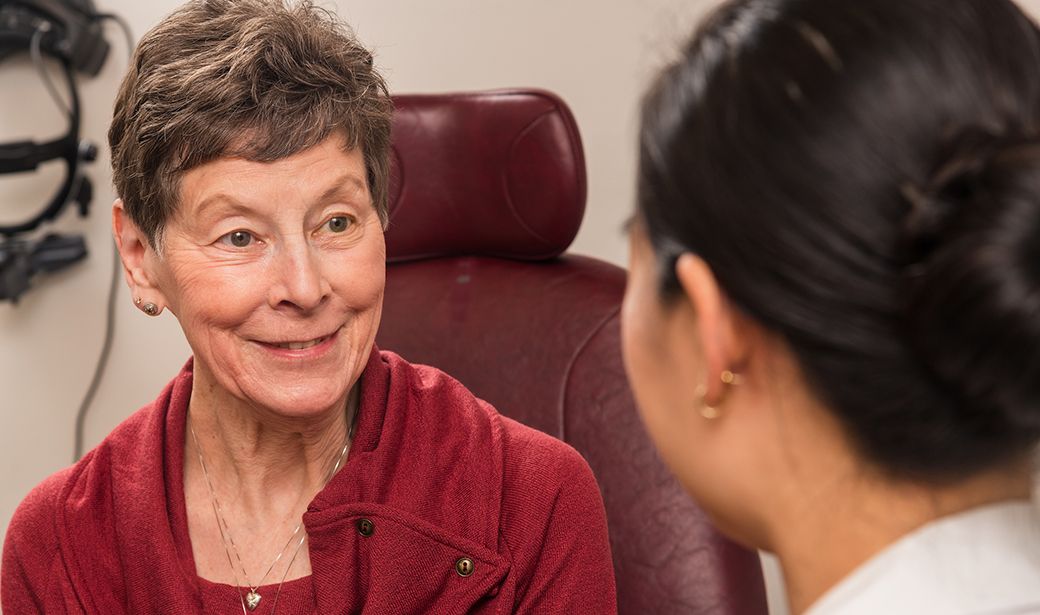Betty Evans is a familiar sight at University of Missouri Health Care’s Ellis Fischel Cancer Center. After working in the medical records department for 10 years, she retired in 2007 and has served as a volunteer at the Ellis Boutique gift shop ever since.
“Our customers are wonderful and include patients, caregivers, staff and former colleagues,” Evans said. “It’s just been fun, and I’m grateful for each and every one of them.”
In late 2016, Evans began experiencing some vision problems and was concerned it might interfere with her lifestyle.
“I initially called to make an appointment to discuss cataract surgery,” Evans said. “I didn’t even know I had glaucoma.”
A common eye disease in older adults, glaucoma happens when fluid builds up in the front part of the eye, putting pressure on the optic nerve. If untreated, glaucoma can cause blindness. With micro-invasive glaucoma surgery — often referred to as MIGS — a patient can be out of surgery within 30 minutes and back to perfect vision within days.
“Glaucoma surgery has evolved significantly in the past five years,” said Jella An, MD, an ophthalmologist and glaucoma specialist at MU Health Care’s Mason Eye Clinic. “MIGS is a group of new glaucoma surgeries that is known to be significantly safer and less invasive than traditional surgery.”
An and Krishna Shanmugam, MD, are the only two fellowship-trained glaucoma specialists in mid-Missouri. Both have performed the MIGS procedure at MU Health Care for a few years and have seen great results in their patients.
“I was having some vision loss, and things were getting a little blurry, which is when I knew I should call and make an appointment,” Evans said. “When I met Dr. An, I immediately felt very comfortable with her. I knew she would take care of my eyes and my vision would be fine.”
The two biggest risk factors for glaucoma are age and eye pressure.
“Eye pressure is the only modifiable risk factor,” An said. “Now we have state-of-the-art diagnostic technologies and extensive research behind it to help detect the disease early and analyze progression using sophisticated algorithms.”
Alleviating eye pressure as quickly as possible reduces the chance of vision loss. That’s where the MIGS procedure can make a big difference. A small incision drains the fluid and reduces eye pressure immediately. This surgery offers patients high-yield vision results with minimal risk factors, especially compared to older glaucoma surgery techniques. It can also be done in conjunction with a cataract surgery, reducing surgeries on the eye, much like Evans underwent.
“As fellowship-trained glaucoma specialists, we’re able to offer the highest quality of patient care and the widest range of glaucoma treatment including a variety of MIGS procedures that can be personalized to each patient’s needs,” An said.
Because glaucoma has no symptoms, regular eye exams are important to help catch glaucoma early. An recommends anyone without risk factors to see an eye specialist at least once at age 40, then every two to four years between ages 40-54, every one to three years between ages 55-64, and every year after age 65, even in the absence of symptoms.
High-risk groups include people with family history of glaucoma, African-Americans, Hispanics and Asian descents, or those with certain medical conditions, such as diabetes and heart disease. An advises high-risk people to see an ophthalmologist more often.
“Many of my patients ask me about the symptoms of glaucoma,” An said. “The answer is by the time you start to have symptoms, it is often too late. So be proactive rather than reactive and go see your eye specialist to have your eyes checked.”
Evans was fortunate she sought help for her cataracts and discovered her glaucoma. The surgery worked perfectly, and the recovery time was so short that didn’t have to miss a volunteer shift at Ellis Boutique.
“I give a lot of hugs, and I’m grateful that I can see to do that,” Evans said. “Because receiving hugs is just as good as giving them.”



